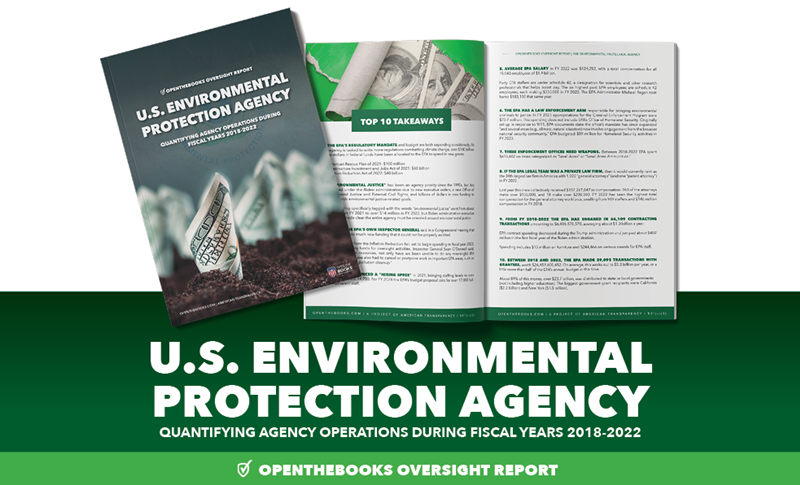

TOP 10 TAKEAWAYS
1. The EPA’s regulatory mandate and budget are both expanding considerably. As the agency is tasked to write more regulations combatting climate change, over $100 billion more dollars in federal funds have been allocated to the EPA to spend in new grants.
American Rescue Plan of 2021: $100 million
Infrastructure Investment and Jobs Act of 2021: $60 billion
Inflation Reduction Act of 2022: $40 billion
2. “Environmental justice” has been an agency priority since the 1990s, but has accelerated under the Biden administration due to new executive orders, a new Office of Environmental Justice and External Civil Rights, and billions of dollars in new funding to direct towards environmental justice-related goals.
Grant spending specifically tagged with the words “environmental justice” went from about $5.6 million in FY 2021 to over $14 million in FY 2022, but Biden administration executive orders have made clear the entire agency must be oriented around environmental justice.
3. In 2023 the EPA’s own Inspector General said in a Congressional hearing that the agency had so much new funding that it could not be properly audited.
The $41.5 billion from the Inflation Reduction Act, set to begin spending in fiscal year 2023, did not include any funds for oversight activities. Inspector General Sean O’Donnell said, “Without adequate resources, not only have we been unable to do any meaningful IRA oversight, but we have also had to cancel or postpone work in important EPA areas, such as chemical safety and pollution cleanup.”
4. The EPA announced a “hiring spree” in 2021, bringing staffing levels to over 15,000 from about 14,700. For FY 2024 the EPA’s budget proposal asks for over 17,000 full-time equivalent staff.
Interestingly, the EPA employs 223 public affairs officers, costing taxpayers over $100 million since 2018.
5. Average EPA salary in FY 2022 was $124,252, with a total compensation for all 15,043 employees of $1.9 billion.
Forty EPA staffers are under schedule 42, a designation for scientists and other research professionals that helps boost pay. The six highest paid EPA employees are schedule 42 employees, each making $250,000 in FY 2022. The EPA Administrator Michael Regan took home $183,100 that same year.
6. The EPA has a law enforcement arm responsible for bringing environmental criminals to justice. In FY 2023 appropriations for the Criminal Enforcement Program were $70.7 million. This spending does not include EPA’s Office of Homeland Security. Originally set up in response to 9/11, EPA documents state the office’s mandate has since expanded “and several areas (e.g., climate, natural disasters) now involve engagement from the broader national security community.” EPA budgeted $89 million for Homeland Security activities in FY 2023.
7. These enforcement offices need weapons. Between 2018-2022 EPA spent $618,602 on items categorized as “Small Arms” or “Small Arms Ammunition.”
8. If the EPA legal team was a private law firm, then it would currently rank as the 34th largest law firm in America with 1,022 “general attorneys” (and one “patent attorney”) in FY 2022.
Last year this crew collectively received $157,267,047 in compensation. 960 of the attorneys make over $100,000, and 18 make over $200,000. FY 2022 has seen the highest total compensation for the general attorney workforce, swelling from 989 staffers and $146 million compensation in FY 2018.
9. From FY 2018-2022 the EPA has engaged in 66,109 contracting transactions amounting to $6,406,870,570, averaging about $1.3 billion a year.
EPA contract spending decreased during the Trump administration and jumped about $400 million in the first fiscal year of the Biden administration.
Spending includes $15 million on furniture and $244,466 on various awards for EPA staff.
10. Between 2018 and 2022, the EPA made 29,093 transactions with grantees, worth $26,459,600,452. On average, this works out to $5.3 billion per year, or a little more than half of the EPA’s annual budget in this time.
About 89% of this money, over $23.7 billion, was distributed to state or local governments (not including higher education). The biggest government grant recipients were California ($2.2 billion) and New York ($1.5 billion).